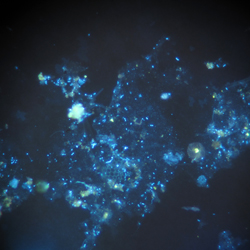On CTD watch, three people ready the CTD for deployment, working on deck to cock the bottles. Once ready, and under the guidance of OTG, two people hold guy lines to steady the rosette as two ABs operate the A frame and winch to bring the CTD off the back deck and lower it into the water. Now responsibility rests on the fourth member of the watch, sitting inside at the data screen and communicating via radio to the bridge and the deck regarding where to send the CTD, how fast to get there, and how long to stay there."Deck, this is CTD lab.Please raise CTD to 75m at 30m per minute." Once the desired bottles at the desired depths have been collected, we return the CTD to the surface, and action returns to the deck.
As soon as it is secured, the CTD becomes a swarm of activity as scientists run around with bottles collecting the water they want for their experiments. Some run off to filter, so they may begin experiments with the water. Others, more concerned with the life in the water than the water itself, begin incubating. Thanks to the CTD data collected at the same time as the water, we know the original temperature of the water from each depth and thus can incubate at those conditions. The more popular depths for water collection correspond to the depths of deployment of other instruments (the sediments traps or net tows, for instance) to make possible experiments with material from multiple sources.
As Tanner described, the CTD deployments are not the only sample collection around here. Lily had exciting news early Wednesday from their net tows done Tuesday night: they found Tricho! Trichodesmium is a filamentous bacterium that is of particular interest to nutrient cycling because of its nitrogen-fixing ability. When your experiments hinge on a certain microbe, it is helpful for that microbe to be present, so for those planning to study Tricho, it was good news to have found some in the samples from the first night's tow.


No comments:
Post a Comment